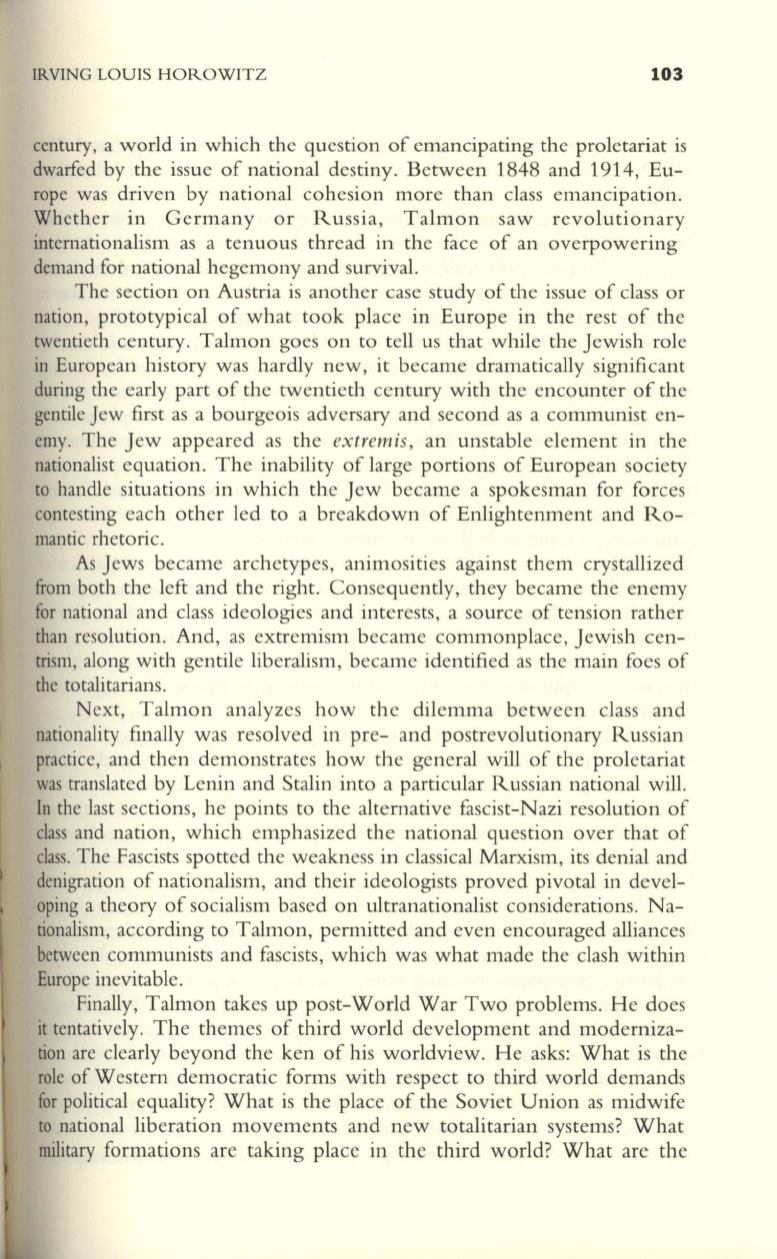
IRVING LOUIS HOROWITZ
103
century, a world in which the question of emancipating the proletariat is
dwarfed by the issue of national destiny. Between 1848 and 1914, Eu–
rope was driven by national cohesion more than class emancipation.
Whether in Germany or Russia, Talmon saw revolutionary
internationalism as a tenuous thread in the face of an overpowering
demand for national hegemony and survival.
The section on Austria is another case study of the issue of class or
nation, prototypical of what took place in Europe in the rest of the
twentieth century. Talmon goes on to tell us that while the J ewish role
in European history was hardly new, it became dramatically significant
during the early part of the twentieth century with the encounter of the
gentile Jew first as a bourgeois adversary and second as a communist en–
emy. The Jew appeared as the
extremis,
an unstable element in the
nationalist equation. The inability of large portions of European society
to handle situations in which the J ew became a spokesman for forces
contesting each other led to a breakdown of Enlightenment and Ro–
mantic rhetoric.
As Jews became archetypes, animosities against them crystallized
from both the left and the right. Consequently, they became the enemy
for national and class ideologies and interests, a source of tension rather
than resolution. And, as extremism became commonplace, Jewish cen–
trism, along with gentile liberalism, became identified as the main foes of
the totalitarians.
Next, Talmon analyzes how the dilemma between class and
nationality finally was resolved in pre- and postrevolutionary Russian
practice, and then demonstrates how the general will of the proletariat
was translated by Lenin and Stalin into a particular Russian national will.
In
the last sections, he points to the alternative fascist-Nazi resolution of
class and nation, which emphasized the national question over that of
class. The Fascists spotted the weakness in classical Marxism, its denial and
denigration of nationalism, and their ideologists proved pivotal in devel–
oping a theory of socialism based on ultranationalist considerations. Na–
tionalism, according to Talmon, permitted and even encouraged alliances
between communists and fascists, which was what made the clash within
Europe inevitable.
Finally, Talmon takes up post-World War Two problems. He does
it tentatively. The themes of third world development and moderniza–
tion are clearly beyond the ken of his worldview. He asks: What is the
role of Western democratic forms with respect to third world demands
for political equality? What is the place of the Soviet Union as midwife
to national liberation movements and new totalitarian systems? What
military formations are taking place in the third world? What are the


